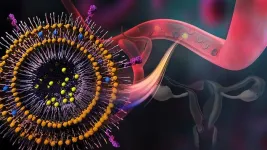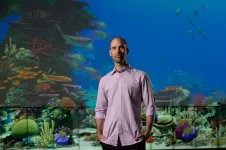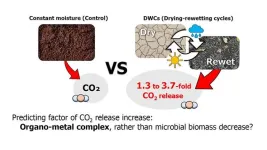(Press-News.org) PORTLAND, Ore. – A new drug delivery system shows promise for treating a rare, aggressive form of cancer affecting pregnant women and new mothers, and it has potential with other cancers as well.
Scientists led by Olena Taratula, a nanomedicine researcher at Oregon State University, have found a way to better ensure the drug used to combat the disease reaches tumor cells without damaging healthy tissue.
Findings of the study into choriocarcinoma, which occurs in the United States at a rate of about four cases per 100,000 pregnancies, were published in Small Science.
Typically starting in the uterus, choriocarcinoma develops from cells that were part of the placenta. It can occur after a miscarriage, abortion or ectopic pregnancy, one in which a fertilized egg implants somewhere other than the lining of the uterus.
It can also happen following a molar pregnancy (no embryo forms, and the placental tissue grows abnormally) and even after a full-term pregnancy.
Taratula and collaborators including OSU postdoctoral researcher Babak Mamnoon and Maureen Baldwin, a physician at Oregon Health & Science University, designed a type of drug nanocarrier known as a polymersome to specifically target a protein in choriocarcinoma cells.
Polymersomes are hollow spheres that are synthetic versions of liposomes, lipid-based sacs found in all living cells. The protein the researchers aimed for is equilibrative nucleoside transporter 1, usually abbreviated as ENT-1, which is important for a range of cellular processes, among them DNA and RNA synthesis.
In addition to being abundant in choriocarcinoma cells, ENT-1 is found in the brain, heart, liver and other tissues in the body.
Mamnoon led the research team in mouse model testing that confirmed attaching guanosine, a building block of RNA, to the polymersome allowed it to deliver more of the chemotherapy drug methotrexate directly to tumor cells.
“Given MTX’s role as the mainstay treatment for choriocarcinoma, the critical goal now is to enhance its effectiveness, including faster response times, while simultaneously minimizing side effects,” said Taratula, an associate professor in the OSU College of Pharmacy.
Methotrexate or MTX, a common cancer drug, works by interfering with cells’ ability to use folic acid, essential for making DNA and RNA. By blocking a certain enzyme, MTX thwarts replication of the otherwise rapidly dividing cancer cells.
Common symptoms of choriocarcinoma are pelvic pain and irregular vaginal bleeding. The cancer can quickly spread via the bloodstream to other parts of the body including bones, gastrointestinal tract, breasts, kidneys, liver, lungs, lymph nodes and brain.
“Because choriocarcinoma occurs in people who were recently pregnant, they often have young families, so we need to make getting diagnosis and treatment easier and faster for them,” said Baldwin, an obstetrician/gynecologist at OHSU.
Most cases, especially if caught early, are curable, with a five-year survival rate of about 87%.
“But MTX has poor tumor specificity in standard applications and can cause side effects such as liver and kidney toxicity,” Taratula said. “That’s why we need a specially designed nanoplatform that ensures precise drug delivery and release directly into tumors.”
In the mouse model, the approach reduced tumor size by 95%, working roughly six times better than non-targeted drug carriers. The upshot is more effective treatment coupled with fewer or less severe side effects, and with further research, the same approach could be applied to treating other cancers, Taratula said.
Financial support for the study came from the OSU College of Pharmacy, the OHSU School of Medicine, the National Institutes of Health, and the Eunice Kennedy Shriver National Institute of Child Health and Human Development.
Collaborators included Oregon State’s Ana Paula Mesquita Souza, Tetiana Korzun, K. Shitaljit Sharma, Oleh Taratula, Yoon Tae Goo, Prem Singh, Vladislav Grigoriev and Aryan Lakhanpal.
END
Researchers find improved method for treating rare, aggressive, pregnancy-related cancer
2025-02-06
ELSE PRESS RELEASES FROM THIS DATE:
Half of the fish you eat comes from the Great Barrier Reef’s marine reserves
2025-02-06
A new study of the Great Barrier Reef has revealed that the network of no-take marine reserves supplies nearly half of the region’s coral trout fishery catch.
The research, led by Professor Michael Bode from the QUT School of Mathematical Sciences and published in Science Advances, revealed that despite covering only 30 per cent of the reef’s habitat, these protected areas account for 47 per cent of the coral trout catch in fishing areas and contribute 55 per cent of the species’ reproduction.
The Great Barrier Reef is protected by a network of marine reserves designed to conserve ...
McDonald’s thwarts council efforts to stop new branches by claiming it promotes ‘healthier lifestyles’
2025-02-06
McDonald's is overturning council attempts to prevent new fast food outlets by claiming they will encourage healthier lifestyles, reveals an investigation published by The BMJ today.
Based on Freedom of Information requests, it shows that the firm has won planning appeals against local authorities in some of the most deprived areas of England, where around 1 in 4 children are obese by the time they leave primary school.
Its tactics include arguing that customers can order salad from its drive-through branches, that they could cycle or walk there, and that its sponsorship ...
Is CBD use during pregnancy as safe as people think? New study uncovers potential risks to babies
2025-02-06
Cannabidiol (CBD), the component in cannabis often used for therapeutic treatments, is increasingly being used during pregnancy as a means of managing symptoms such as nausea, anxiety and sleep. Though the public perception is that CBD – particularly when consumed orally – is safer and helpful for symptom management, little is known about the impact of CBD on pregnancy.
A new study from McMaster University researchers fills that gap in knowledge and has uncovered potential risks, including impaired fetal growth, associated with the use of both tetrahydrocannabinol (THC), the ...
Drying and rewetting cycles substantially increased soil CO2 release
2025-02-06
Niigata, Japan - The amount of carbon dioxide (CO2) released by microbial decomposition of soil organic carbon on a global scale is approximately five times greater than the amount of anthropogenic CO2 emissions. Thus, it is essential to clarify the impact of climate change on soil CO2 release dynamics.
A collaborative research group consisting of Dr. Hirohiko Nagano and Ms. Yuri Suzuki of Niigata University with researchers of Kyushu University and the Japan Atomic Energy Agency conducted incubation experiments on forest and pastureland soils at 10 locations across Japan. The research group revealed ...
Hybrid job training improves participation for women in Nepal, study finds
2025-02-05
URBANA, Ill. – Globally, women’s workforce participation is about 25% lower than men’s, often due to barriers such as domestic responsibilities and cultural norms. Vocational training can increase employment opportunities, but women may not be able to attend training programs that require them to be away from home. A new study from the University of Illinois Urbana-Champaign, in collaboration with an international research team, explored whether hybrid distance learning can improve accessibility to ...
Understanding aging requires more than counting birthdays
2025-02-05
UNIVERSITY PARK, Pa. — People’s bodies can be old or young for their chronological age, depending, in part, on the amount and types of stressors they have experienced. Scientists can estimate people’s biological age, but whether they use oral tissue or blood to make the measurement matters, according to a new study led by researchers in the Penn State Department of Biobehavioral Health.
Biological age — a measure of how well one’s body is functioning — differs from chronological age — the amount of time since someone was born. While chronological age can be correlated to disease risk, researchers and medical ...
AI tool helps find life-saving medicine for rare disease
2025-02-05
After combing through 4,000 existing medications, an artificial intelligence tool helped uncover one that saved the life of a patient with idiopathic multicentric Castleman’s disease (iMCD). This rare disease has an especially poor survival rate and few treatment options. The patient could be the first of many to have their lives saved by an AI prediction system, which could potentially apply to other rare conditions.
Detailed in a new paper published in NEJM, a group led by researchers at the Perelman School of Medicine at the University of Pennsylvania used an AI technique called machine learning to determine that adalimumab—a ...
A new tool could exponentially expand our understanding of bacteria
2025-02-05
How do bacteria — harmless ones living in our bodies, or those that cause disease — organize their activities? A new study, combining powerful genomic-scale microscopy with a technical innovation, captured which genes bacteria turn on in different situations and in different spatial environments. The technology, described January 23 in Science, promises to take the study of bacteria to the next level.
Jeffrey Moffitt, PhD, and colleagues in the Program in Cellular and Molecular Medicine (PCMM) at Boston Children’s Hospital applied MERFISH, a molecular ...
Apply for the Davie Postdoctoral Fellowship in Artificial Intelligence for Astronomy
2025-02-05
February 5, 2025, Mountain View, CA -- The SETI Institute announced the Davie Postdoctoral Fellowship in Artificial Intelligence for Astronomy, inviting researchers to refine and expand ML-driven pipelines for exoplanet discovery. The successful candidate will join the SETI Institute researcher Dr. Vishal Gajjar and his team and collaborators at the SETI Institute and IIT Tirupati in India. This project will focus on enhancing supervised CNN architectures and integrating anomaly-detection techniques to uncover subtle or unconventional signals hidden within massive datasets. The application deadline is March 15, 2025. Information about how to apply is here.
“Machine ...
New study finds students' attitudes towards computer science impacts final grades
2025-02-05
University of Delaware Associate Professor Teomara Rutherford, along with UD co-authors Hye Rin Lee, Austin Cory Bart and Andrew Rodrigues and Megan Englert of the University of Colorado Boulder, investigated changes in student motivation in first-year university CS courses. Although students’ perception of the value of CS declined over the semester, their sense of belonging and beliefs in their ability to succeed increased. Rutherford and her co-authors also found that students’ beliefs in their ability to succeed, their view of the course’s importance and their perception of its emotional cost ...





